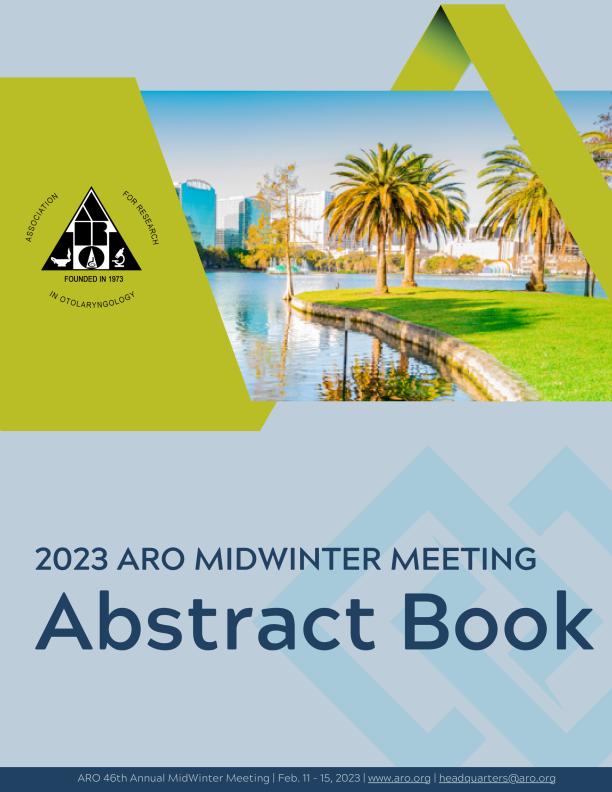Evento
Co-Release of GABA and ACh from Medial Olivocochlear Efferent Fibers During Development
Tipo del evento:
Congreso
Nombre del evento:
ARO 46th Annual Midwinter Meeting
Fecha del evento:
11/02/2023
Institución Organizadora:
Association for Research in Otorrinolaringology;
Título del Libro:
2023 ARO Midwinter Meeting Abstrac Book
Editorial:
Association for Research in Otorrinolaringology
Idioma:
Inglés
Clasificación temática:
Resumen
During development, inner hair cells (IHCs) in the mammalian cochlea are unresponsive to acoustic stimuli but instead present intrinsic electrical activity, crucial for the normal development of the auditory pathway. During this same period, neurons originating from the medial olivocochlear complex (MOC) transiently innervate the soma of IHCs. This synapse is mediated by acetylcholine (ACh), activating nicotinic receptors assembled by alpha9 and alpha10 subunits and ultimately controlling IHC excitability. Although it is a cholinergic synapse, previous evidence indicated the presence of abundant GABA and presynaptic GABAB receptors (GABAB-R). Moreover, application of GABAB-R agonists generated a reduction in ACh release. Transgenic Chat tm2(crc)Lowl/J-Cre (ChAT-cre) and Gad2 tm1(cre/ERT2)Zjh/J-Cre (GAD2-cre) mice of either sex were mated with a floxed channel rhodopsin 2 (ChR2) line, Ai32, to drive specific ChR2 expression. Whole cell patch clamp was performed in P9-11 IHCs while either cholinergic (ChATCre/ ChR2) or GABAergic (GAD2-Cre/ChR2) fibers were optogenetically stimulated. Additionally, immunohistochemistry techniques were used to characterize cholinergic and GABAergic expression in B6.Cg-Gt(ROSA)26Sortm14(CAG-tdTomato)Hze/J (tdTomato) crossed with GAD2-Cre. Furthermore, we performed calcium imaging experiments at the same age range on Balb-C mice. For this, IHCs were dialyzed with a fluorescent calcium indicator (Fluo 4) and MOC electrically stimulated during the application of a GABAB-R antagonist (CGP 36216, 200 μM). Firstly, eIPSCs were optogenetically triggered in ChAT-cre/ChR2 mice, and these responses could be partially blocked with alpha-bungarotoxin (60.8 ± 4.4%, N=5). Optogenetic experiments were also performed in GAD2-cre/ChR2 mice producing eIPSC that could also be blocked by alpha-bungarotoxin (82.3 ± 7.2%, N=4). This result strongly suggests that a cholinergic response could be elicited in IHC in GAD-expressing neurons. Also, immunohistochemistry experiments done at the base of IHCs showed approximately 30% co-localization of GABAergic and cholinergic labelling. Finally, calcium imaging experiments were performed with stimulation of MOC fibers, allowing us to resolve the activation of single synaptic sites. The application of the GABAB-R antagonist, CGP 36216, produced an increase in the activation probability of individual calcium hotspots in the context of heterogeneous responses in different sites of a single IHC. In conclusion, here we provide evidence suggesting that GABA and ACh could be co-released from MOC terminals. Whereas ACh acts postsynaptically activating α9α10 receptors, the role of GABA is presynaptic, as a negative feedback signal to locally regulate cholinergic inhibition of IHCs. Calcium imaging experiments suggest that GABA modulation operates differently at each synaptic site.
Palabras clave:
COCHLEA
,
OPTOGENETIC
,
CALCIUM IMAGING
,
OLIVOCOCHLEAR
Archivos asociados
Licencia
Identificadores
Colecciones
Eventos(INGEBI)
Eventos de INST.DE INVEST.EN ING.GENETICA Y BIOL.MOLECULAR "DR. HECTOR N TORRES"
Eventos de INST.DE INVEST.EN ING.GENETICA Y BIOL.MOLECULAR "DR. HECTOR N TORRES"
Citación
Co-Release of GABA and ACh from Medial Olivocochlear Efferent Fibers During Development; ARO 46th Annual Midwinter Meeting; Orlando; Estados Unidos; 2023; 1-1
Compartir




